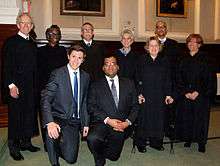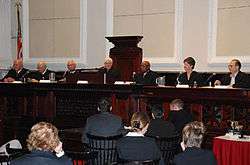National Moot Court Competition
The National Moot Court Competition is one of the oldest moot court competitions in the United States. Co-sponsored by the New York City Bar Association and the American College of Trial Lawyers, the competition includes up to 191 teams from 124 law schools, who compete in regional competitions in November with the top two in each region advancing to the national competition held in the landmark House of the New York City Bar Association in February.[1]
History

The National Moot Court Competition was created in 1947 by Harrison Tweed, then president of the New York City Bar Association, as part of a campaign to recruit younger members to the City Bar in the years following World War II.
The first competition was held at the City Bar’s building in January 1950. Twelve law school teams debated the legality of “rainmaking,” or the use by farmers of rainmaking devices to divert water from adjacent land. The program was formatted as a mock appeal, in order to develop the skills of appellate advocacy among law students.[2]
In the years since, the moot court competition has expanded to include competitions in 15 regions throughout the continental United States.[3] The cases argued traditionally focus on a timely issue arising under the United States Constitution, in keeping with the competition’s original theme of appellate advocacy. The final national competition continues to be held in New York, and the final argument between the top two teams is judged by a seven-person mock court, including prominent jurists, the president of the New York City Bar Association and the president of the American College of Trial Lawyers.
Organization

In both the regional and national competitions, all teams are required to argue the same single case on appeal. The case consists of two issues drawn from current legal issues that are likely to be considered by the Supreme Court in the near future. The cases are devised and prepared each year by the Young Lawyers Committee of the New York City Bar Association.
The National Moot Court Competition begins on the regional level. The United States is divided into fifteen regions, each of which hosts its own regional competition for teams whose law schools fall within their jurisdiction. Each fall, the New York City Bar Association invites all ABA-accredited law schools to field moot court teams of two to three students to participate in regional competitions. The regional winners and runners-up compete in a four-day national competition, as the 30-team field narrows to sixteen, eight, four, two, and ultimately one champion over the course of the competition.
The best overall team is presented with the Fulton Haight Award,[4] which includes a trophy and a cash reward. The team presenting the best oral arguments is awarded the John W. Davis award, which includes an engraved silver cup. Best individual speaker and runner-up for best individual speaker are both awarded crystal obelisks by the American College of Trial Lawyers.
Rules
Every participating team is required to submit a brief in advance of the regional and (if they qualify to attend) national competitions. At each competition, teams are required to argue both sides of their appeal. Competitors are judged 40% on written briefs, and 60% on oral presentation. The Competition is administered by, and governed by Rules drafted by, the New York City Bar’s Young Lawyers Committee.
Notable Past Participants
The National Moot Court Competition has attracted a prestigious roster of past judges and competitors. United States Supreme Court Justices Thurgood Marshall, Potter Stewart, Byron White, William Rehnquist, Ruth Bader Ginsburg, Sandra Day O’Connor, and Anthony Kennedy have all judged past final rounds. Other notable judges have included Hon. Barrington D. Parker, Hon. Judith S. Kaye, and Hon. Amalya Kearse.
Past Champions
2016: Texas Tech University School of Law - Kristen Vanderplas, C.J. Baker, Shelby Hall [5]
2015: George Washington University Law School - Kyle Singhal and Dane Shikman [6]
2014: University of Georgia School of Law- Steven Strasberg, Ben Thorpe, Emily Westberry [7]
2013: Stetson University College of Law- Julia McGrath, Victoria San Pedro, Andrew Harris
2012: Texas Tech University School of Law - Brandon Beck, Allie Hallmark, and Elizabeth Hill
2011: Texas Tech University School of Law - Alexis Butler, Daniel Durell, and Jason Jordan
2010: University of Arkansas School of Law - Ashley Driver, Taylor Mattson, Allison Waldrip
2009: Chicago-Kent College of Law - Andrew Booth, Brody Dawson, Betsy Gates
2008: Chicago-Kent College of Law - Joanna Brinkman, Lalania Gilkey-Johnson, Rachel Moran
2007: University of Washington School of Law - Dustin Buehler, Candice Tewell, Aaron Thomson
2006: Duke University School of Law - April Nelson, Sara Wickware, Audry Casusol
2005: University of California Hastings College of Law - Leah Bolstad, Mark D'Argenio, Eliza Hoard
2004: South Texas College of Law - Marit M. Babin, Kenneth O. Corley, J. Daniel Johnson
2003: Wayne State University Law School - Dana Bennett, Jennifer Savage, Caroline Whittemore
2002: University of California Hastings College of Law - Robert Hodil, Mohammad Keshavarzi, Joel Muchmore
2001: Drake University Law School - Theodore Sims II, William D. Schultz, Jeffrey Link
2000: University of Montana School of Law - Bobbi Frazer, John Mudd, Taryn Stampfl
References
- ↑ http://www.nycbar.org/law-students/national-moot-court
- ↑ “Fifty Years of Moot Court.” 44th Street Notes. February, 2001. p. 3. Published by the New York City Bar Association.
- ↑ http://www.nycbar.org/law-students/national-moot-court/competition-rules
- ↑ http://www.actl.com/Content/NavigationMenu/AboutUs/AwardsandCompetitions/NationalMootCourt/default.htm
- ↑ http://www.nycbar.org/44th-street-blog/2016/02/16/texas-tech-university-school-of-law-wins-national-moot-court-competition-2/
- ↑ https://services.nycbar.org/iMIS/Events/Event_Display.aspx?EventKey=MOOTCO2015
- ↑ http://www.nycbar.org/44th-street-blog/2014/02/14/university-of-georgia-wins-national-moot-court-competition/
Sources and External Resources
- “Fifty Years of Moot Court.” 44th Street Notes. February, 2001. Published by the New York City Bar Association.
- National Moot Court Competition, New York City Bar Association.
- American College of Trial Lawyers.